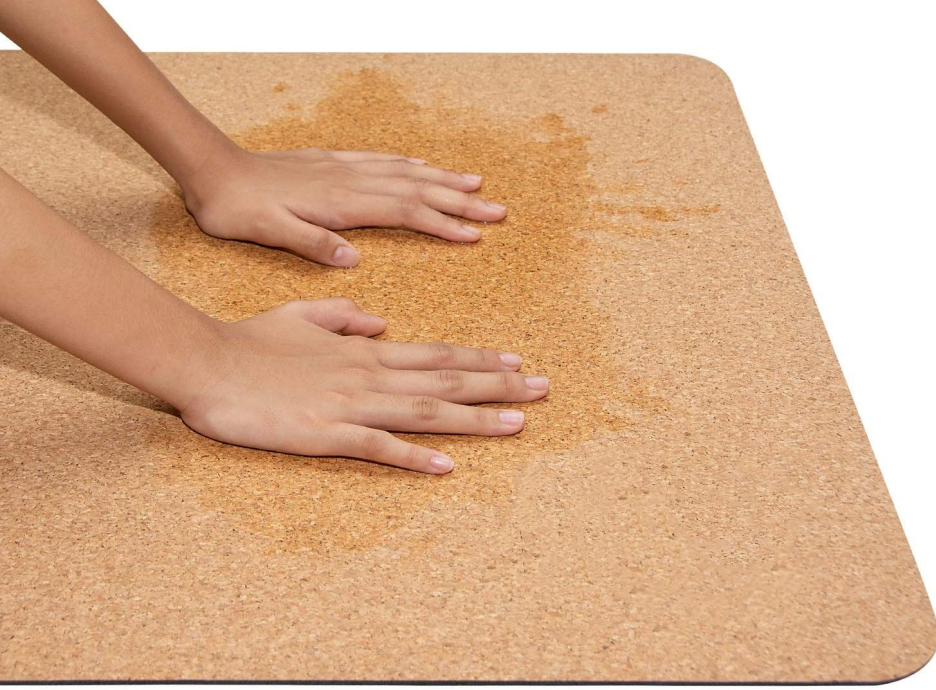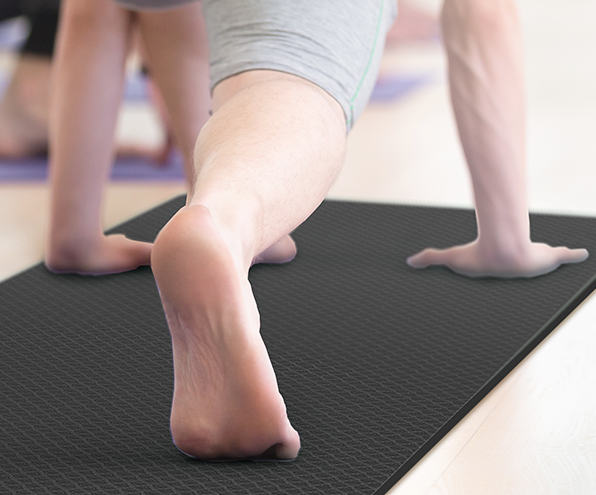I believe a yoga mat’s grip is vital for everyone practicing yoga, no matter their experience. Good grip makes you more stable. This helps you concentrate on your yoga, not on slipping.

The Risks of Slippery Mats
In dynamic yoga styles (e.g., Vinyasa, Power Yoga), grip is everything. Slippery mats hurt your performance and can cause injuries. A lack of grip can cause you to lose balance, increasing the risk of falls and strains. Also, if a brand sells mats that don’t grip well, users might think badly of that brand. In my experience, this can really damage a brand’s image.
The Competitive Edge
If you’re a B2B buyer, I suggest offering mats with great grip. This makes your brand stand out. I’ve seen that customers prefer products that are safe and help improve their yoga. I find that when you focus on this important detail, you meet what yoga lovers need. This helps build loyalty to your brand.
What “Grip” Means for Yoga Mats
I think grip in yoga mats is about how well the mat keeps you steady during different poses. It’s very important to help prevent slips. From my experience, a good grip helps you focus on your practice instead of worrying about a potential fall.
Types of Grip I Suggest You Consider
Dry Grip: Dry grip refers to how well the mat holds when your hands and feet are dry—usually at the beginning of practice. I find that a mat with excellent dry grip provides strong stability for balance-focused poses like Tree or Warrior III. It’s especially helpful during transitions, where a secure foundation allows you to move confidently and maintain alignment.
Wet Grip: Wet grip becomes essential as your session intensifies and you start to sweat, particularly in hot yoga or vigorous Vinyasa flows. I always recommend mats specifically engineered for strong wet traction. These mats prevent slipping even when moisture builds up, helping you stay safe and focused throughout the class. A good wet grip can make the difference between a smooth flow and a frustrating or risky practice.
Why Surface Texture is Important
Open-cell vs Closed-cell Design: In my experience, open-cell mats often give better cushioning and grip. However, they can absorb moisture. Closed-cell mats are easier to clean and tend to be more durable. I’ve noticed they might offer less grip if you’re sweating a lot.
How Material Affects Grip
Natural Rubber: I believe natural rubber is one of the best materials for yoga mats when it comes to both performance and longevity. It offers excellent grip, especially in dry conditions, and holds up well over time, even with frequent practice. If you’re a dedicated yogi who practices several times a week, this is a solid, eco-conscious choice.
TPE: TPE is a newer-generation material that strikes a good balance between performance and environmental impact. I think it provides decent grip, lightweight portability, and softness underfoot. For those looking for an eco-friendlier alternative to PVC, especially for moderate use, TPE is a great option that’s also recyclable.
PVC: PVC mats are known for their durability and dependable grip. My observation is that while they perform well—especially in terms of stickiness and firmness—they are less eco-friendly compared to other materials. They’re often best suited for beginners or budget-conscious users who prioritize long wear over sustainability.
Cork: Cork is a unique and increasingly popular material in the yoga world. It offers a natural, earthy texture and surprisingly good grip that actually improves with moisture—making it ideal for sweaty sessions or hot yoga. I find it delivers a grounded feel and also has antimicrobial properties, which help keep the mat fresh over time.

I believe finding the right mat for you involves thinking about your practice style, your personal preferences, and any environmental concerns you might have.
Top Materials for the Best Grip
I find that picking the right material for your yoga mat can make a big difference to your grip during practice. Let’s explore some top materials known for their excellent grip.
Material Overview
| Material | Dry Grip | Wet Grip | Durability | Eco-Friendliness | Ideal For |
|---|---|---|---|---|---|
| Natural Rubber | ✅✅✅ | ✅✅✅ | High | High | Vinyasa, Hot Yoga |
| PU-Coated Natural Rubber | ✅✅✅ | ✅✅✅ | High | Medium | Hot Yoga, Professional Use |
| Cork + Rubber Base | ✅✅ | ✅✅ | Medium | High | Sweaty Hands, Eco Brands |
| TPE | ✅ | ✅ | Medium | High | Beginners, General Use |
Natural Rubber
I think natural rubber mats are fantastic due to their excellent grip and durability. They easily manage high-intensity practices like Vinyasa and Hot Yoga. In my experience, I also appreciate their eco-friendliness; it’s a big plus for me.
PU-Coated Natural Rubber
This material, in my opinion, offers a great balance of performance and comfort. PU-coated mats give you superb grip whether you’re dry or sweating. I believe they are very suitable for hot yoga or for professional use.
Cork + Rubber Base
From my perspective, cork is a unique option. It combines sustainability with good grip. I find it performs well, and it’s great if you tend to have sweaty hands. The rubber base adds stability, and I like that this combination remains an environmentally sound choice.
TPE
I’ve seen TPE mats becoming quite popular, especially with beginners. In my view, they offer a reasonable amount of grip in both dry and wet conditions. They are lightweight and a more planet-friendly option, making them, I believe, great for everyday use.
Best Grip Yoga Mat Brands (Including Custom Options)
If you’re looking for yoga mats with the best grip, I find several brands are known for great performance and cool designs. I want to show you some top choices, even custom ones.
Premium Brands
Manduka PRO & GRP: I think these mats have amazing grip. They are a top choice if you want something premium. They last long and are very stable. The price is higher, so they might not be the best for selling in large quantities to a wide audience.

Liforme Yoga Mat: I really like this brand. People praise it for its great grip. It also has markers to help you align your poses correctly. I recommend this mat for boutique studios. It can make their customers’ experience even better.

Custom Options
Wuhan FDM Eco Fitness (Custom Manufacturing): From my experience, this company is great for custom yoga mats. They use materials like TPE, Natural Rubber, and PU. I’ve seen their mats have anti-slip surfaces. These work well whether you’re dry or sweaty. I suggest them for yoga studios and yoga mat wholesalers.

Value for Money
Gaiam Cork Yoga Mat: I like this mat because it’s made with the environment in mind. It blends cork and rubber, which gives it a natural touch. It provides good grip, even if your hands get sweaty. I find it’s a good price for a mat that’s also sustainable.
Liforme Eco Yoga Mat: This one costs a bit more, but I think it offers a fantastic grip for many yoga styles. I’ve noticed that customers who care about the planet often choose this mat because the company focuses on being kind to the environment.
What to Look for in a Supplier If Grip Is Your Top Priority
If you’re looking for yoga mats with the best grip, I recommend finding suppliers who really understand this key feature. Here are some things I suggest you think about:
Grip-tested materials
I recommend choosing suppliers who can provide certified lab test results or real-world user testing data for mat grip performance. These results should clearly show how the mat performs in both dry and wet conditions. From my experience, this is one of the most reliable indicators of overall material quality, especially for styles like Vinyasa or hot yoga where traction is critical.
Custom surface texture options

Consider suppliers that offer a variety of surface textures—such as wave, leaf, or diamond patterns. In my opinion, these textures do more than enhance grip; they also add a distinctive aesthetic to your mats. The right texture can improve user experience and help your brand stand out in a crowded market.
Private labeling or logo branding

I suggest partnering with suppliers who allow custom branding, including private labels and logo printing. This is essential if you want to grow brand recognition and deliver a personalized experience to your clients. From what I’ve seen, strong branding on a high-quality mat can significantly boost your visibility and credibility.
Pre-production samples
A trustworthy yoga mat supplier should be willing to send pre-production samples before you commit to a large order. This gives you the chance to evaluate the mat’s grip, comfort, texture, and overall quality firsthand. I always make it a point to test samples—it minimizes risks and ensures the final product aligns with your brand’s standards.
Pricing and after-sales support
Make sure your supplier offers competitive pricing for bulk orders along with responsive after-sales service. Whether it’s handling returns, answering technical questions, or resolving issues quickly, reliable support helps keep your customers satisfied. In my experience, good after-sales care builds long-term relationships and encourages repeat business.
Expert Opinion:
“I’ve worked with many suppliers throughout my career. From my experience, I suggest that suppliers who understand grip testing can greatly improve your business. When a supplier shares detailed friction coefficient data and real-world slip resistance metrics, I know they are committed to quality. I always make sure to see how their mats perform with different moisture levels – from bone dry to soaked with sweat. I find this data proves the product’s quality. It also gives you strong selling points. These points appeal to yoga instructors and serious practitioners who consider safety their main concern.“
———— Sarah Chen , Senior Product Development Manager with 12+ years in yoga equipment sourcing and B2B wellness product distribution
My Final Take: Focus on Grip, Safeguard Your Brand
For yoga mats, I think grip must be your main concern. A mat with good grip is crucial for safety. It helps prevent slips and injuries during yoga. This improves how users feel about the mat. It also protects your brand’s good name. When customers feel safe, they tend to come back. They also tell others about your products.
Why I Believe Grip is So Important for Happy Customers
A mat with great grip helps people concentrate. It boosts their confidence. This lets them focus completely on their yoga poses. I’ve seen slippery mats cause frustration. They can harm your brand’s image. In my experience, customers think poor grip means a low-quality mat. This can reduce your sales.
My Tips for Choosing Good Suppliers
I suggest you team up with suppliers. Make sure they focus on grip in their products. I recommend asking for test results. These should show grip quality in dry and wet situations. From my perspective, this data is very useful. Custom surface textures can make the grip even better. I’ve found this to be a good option to explore.
My Advice on Marketing
I advise you to focus your marketing messages. Talk about the benefits of good grip. Show customer stories and real examples. These should feature people having good experiences with the grip. I’ve seen this approach build customer trust. It also helps create loyal customers. A safe mat is more than just an extra item. I believe it’s a core part of a good yoga session.

